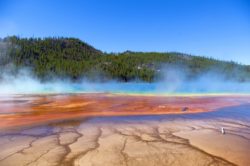Geothermal energy potential of closed loop borehole heat exchangers

Project lead: Professor Fleur Loveridge
Project objectives
- To understand the impact of different fracture flow characteristics on the heat transfer processes within and around closed loop borehole heat exchangers
- To recommend the best borehole designs to exploit groundwater flow through fractures
- To assess the implications of aquifer heterogeneity on downstream thermal plume developments
Summary of the project
Geothermal Energy Potential of Closed Loop Borehole Heat Exchangers in Heterogeneous Aquifers
Closed loop ground heat exchangers are typically boreholes constructed to between fifty and several hundred metres depth and installed with plastic heat transfer pipes to allow connection to ground source heat pumps or district heating systems. They are likely to be the work horse of much of shallow geothermal energy exploitation in the UK. Currently these ground heat exchangers are typically backfilled with grout and function purely through diffusive processes in the ground. However, in many formations present beneath UK urban centres (e.g. Chalk, Sherwood Sandstone) groundwater may be present and regional or local hydraulic gradients will cause additional advective heat transfer. This process is rarely taken account of in closed loop ground heat exchanger design, although construction sometimes tries to encourage the beneficial effects of groundwater by backfilling with coarse gravel. In other parts of the world with more competent geology, holes maybe left open to encourage thermally induced water movement as well. Furthermore, other alternative ground heat exchanger designs like co-axial systems are also being increasingly adopted in the UK.
Where groundwater flow is matrix dominated, classical porous media flow may be assumed and analysis to understand the benefits of groundwater flow to an individual or fields of ground heat exchangers may be calculated by existing techniques. The risks in terms of thermal plume development may also be assessed by these techniques. However, there is a lack of understanding about the role of fractures or other aquifer heterogeneity in controlling the ground heat transfer around closed loop ground heat exchangers. This research project will consider several realistic scenarios where fracture intersect closed loop ground heat exchangers based on characterisation of a real site in the Chalk. The project will use numerical modelling to understand how different fracture characteristics will interact with different borehole designs to affect the heat available from individual ground heat exchangers, and also assess the potential for downstream environmental impacts
Project outcomes
This project will develop recommendations about how to best construct closed loop borehole heat exchangers within aquifers to maximise heat transfer while also meeting environmental safeguards. It will also allow the estimation of downstream thermal impacts in heterogeneous aquifers, by considering how thermal plumes may be affected by different fracture flow conditions
